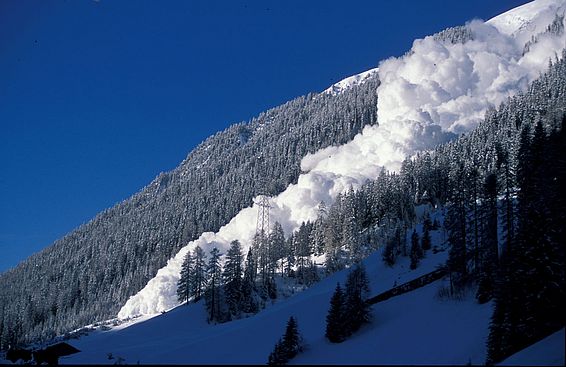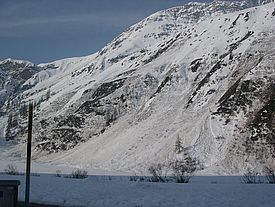Climate change is having an impact on avalanche activity. Wet snow avalanches can be expected earlier and more frequently, while instabilities in dry snowpack are becoming less common. Unexpected changes in the weather, such as rain in midwinter, will continue to make the work of avalanche warning services and rescue workers challenging, not only in open terrain but also in ski resorts.
Less snow does not mean fewer avalanches. SLF researchers have investigated the effects that climate change will have on avalanche activity in Switzerland above 1,800 m. The number of dry avalanches will decline, but this will be accompanied by an increase in the number of wet snow avalanches, depending on the climate scenario, even during the peak tourist season. This impact will only be marginally apparent in the next few decades, but will become increasingly noticeable by the end of the century. However, avalanche safety services have very little scope for triggering wet snow avalanches artificially. The only countermeasure in an emergency is to temporarily close at-risk areas of a ski resort. Moreover, it is harder for avalanche warning services to assess the situation when the snow is wet than it is in dry conditions.
The good news is that avalanches are likely to reach valleys less frequently in the future. In addition, warmer temperatures will mean that fewer and fewer weak layers form in the snowpack, making it less likely that recreational sports enthusiasts will trigger avalanches. However, these individuals should also be paying more attention to the issue of wet snow avalanches, as these will become more common in midwinter.
To obtain a more nuanced picture of the effects of climate change on avalanche risk, SLF researchers have, for the first time, simulated snowpack and snow flow behaviour in detail for multiple climate scenarios. This means that they can estimate how stable the snowpack will be depending on the scenario, what the runout distance of avalanches will be and what pressure they will exert.
SLF researchers predict that in the long term, towards the end of the 21st century, there will on average be a definite decrease in the danger posed by snow masses. While average trends can be estimated using current climate scenarios, it is uncertain whether and to what extent extraordinary weather conditions with heavy snowfalls will occur in the future. It is these rather extreme situations that lead to intense and widespread avalanche activity throughout the Alps. This is because very large avalanches that extend into valleys are the result of a few days of intense precipitation owing to unusual weather conditions. There are currently no reliable projections for this, as current climate scenarios do not adequately represent such extreme weather situations. However, in the short term, over the decades to come, the danger could increase at high altitudes. While lower altitudes will become safer, more intense precipitation at higher altitudes will produce more snow, meaning that larger avalanches that exert more pressure are to be expected.
In practical terms, this has implications for infrastructure in exposed locations, such as the mountain huts of the Swiss Alpine Club (SAC). According to an SLF study, avalanches pose a risk to 66 of the 153 huts. For some, climate change will increase the risk, while for others it will reduce it. For example, if a glacier recedes, the avalanche starting zone may get bigger. At the same time, this may also mean that avalanches will have more room to run out and so will no longer reach buildings that were previously at risk. However, in the case of the SAC's Fridolinshütte on the Tödi, the threat comes not from a snow but from an ice avalanche. If the glacier high above the hut, which is currently frozen, becomes unstable due to climate change, several million cubic metres of ice could plunge down into the valley.
Previously published in this series: ¶
- Part 1: Climate change and… winter sports
- Part 2: Climate change and... biodiversity
Contact ¶
Media Office SLF
- Telephone: +41 81 417 01 90
- E-Mail: medien(at)slf.ch
Links ¶
Copyright ¶
WSL and SLF provide image and sound material free of charge for use in press releases in connection with this media release. The use of this material in image, sound and/or video databases and the sale of the material by third parties is not permitted.

